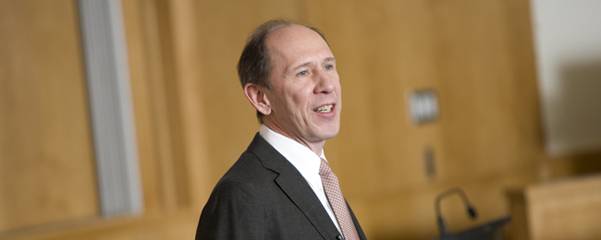Pay to Play: Tallying the Costs of Active Investing
Investor behavior has long been at odds with investor wisdom. Most investors chase potential profits by actively buying and selling stocks—or by hiring someone else to do it for them—although trading costs and management fees significantly reduce their net returns. New research by Tuck Professor Kenneth R. French quantifies the costs of such active investing and provides strong evidence that a passive approach is better for most investors.

Investor behavior has long been at odds with investor wisdom. Most investors chase potential profits by actively buying and selling stocks—or by hiring someone else to do it for them—although trading costs and management fees significantly reduce their net returns. New research by Tuck Professor Kenneth R. French quantifies the costs of such active investing and provides strong evidence that a passive approach is better for most investors.
Analyzing U.S. market data from 1980 to 2006, French finds that, on average, investors spend 0.67 percent of the aggregate value of the market each year searching for superior returns. He calls active investing a negative sum game. Every dollar a savvy investor earns must come at the expense of less successful investors. And active investors also need to recoup trading costs and fund fees. "Most active investors," he says, "are wasting money on a futile search for superior returns."
The cost of active investing remains remarkably constant over French's 27-year study period, despite such seismic changes as a four-fold increase in annual market turnover, a substantial reduction in trading costs, and plummeting of the market share held by individuals from 47.9 percent in 1980 to 21.5 percent in 2006. Nonetheless, in all but three of the 27 years, investors spent between 61 and 74 basis points of the aggregate value of the U.S. stock market searching for superior returns.
Although trading costs fell dramatically in this period, the advent of hedge funds filled the cost gap. French notes that for hedge fund investors to pay just their fees, the funds would have to beat the market by an average of 4.26 percent per year from 1996 to 2007. For investors in funds of hedge funds, the figure rises to 6.52 percent—and these estimates ignore the other costs incurred by hedge funds and funds of funds.
French estimates that active investing in the U.S. stock market cost society $102 billion in 2006. If the dollar cost remained constant at $102 billion per year, the capitalized cost of future active investing would be about 10 percent of the total value of the market. And if the annual cost grew with the market, remaining at about 67 basis points, the capitalized cost would be between 15 and 20 percent of the current market value. Thus, on a capitalized basis, society will consume between 10 and 20 percent of the current value of the market trying to beat the market.
A passive strategy, such as index funds, may not be sexy, but his research leaves little doubt that it is the best strategy for individual investors.
Active trading does have value, of course; it improves the accuracy of financial prices, which is good because the rest of society uses these prices when deciding how to allocate resources. But this price discovery is an externality. Each investor gets the benefit of more accurate prices even if he or she does not help pay for them.
So why do investors continue to play a game that, on average, they have to lose? "Lots of things conspire to keep people confused about the negative sum nature of active investing," French says. Wall Street's core message, for example, is that active investing is both easy and profitable. And the financial press reinforces that message. "Even I would not continue to read a column that says 'passive investing is better than active investing' week after week," French explains. "Stories about active managers are far more interesting."
A passive strategy, such as index funds, may not be sexy, but his research leaves little doubt that it is the best strategy for individual investors. French estimates that a portfolio combining the actual strategies of all investors in the U.S. stock market, including their cost of investing, would have produced a cumulative return of 490 percent from 1980 to 2006, and a passive market portfolio would have produced a return of 582 percent over the same period, after subtracting the cost of passively investing. Equivalently, an investment of $1,000 would have grown to about $4,900 in the aggregate portfolio and $5,820 in the passive market portfolio. "The big difference shows the power of compounding," French says. "The 67 basis points of extra cost per year reduces the average investor's cumulative return by 92 percentage points from 1980 to 2006."
He is quick to note that some superior investors may be smart enough to beat the market consistently, but active investing is still a negative sum game. And although French is head of investment policy for Dimensional Fund Advisors, a money management firm that emphasizes efficient portfolio design and execution, he declines to put himself in the company of those superior investors. When asked why he does not use his knowledge to invest actively, he says, "I know enough to not try."
Tuck encourages readers to seek professional advice before making investment decisions.
French K R: Presidential Address: The Cost of Active Investing, The Journal Of Finance, 63(4), August 2008. Kenneth R. French is the Carl E. and Catherine M. Heidt Professor of Finance at Tuck. He served as president of The American Finance Association from 2007 to 2008.